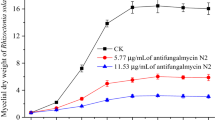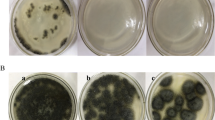Abstract
Antifungalmycin N2 (3-methyl-3,5-amino-4-vinyl-2-pyrone, C6H7O2N) was a novel structural antifungal metabolite produced by Streptomyces sp. strain N2. Our previous study reported that the antagonistic interaction between antifungalmycin N2 and Rhizoctonia solani was accompanied by an oxidative stress in R. solani cell, indicating a probable damage occurred in the cell membranes and mitochondria. To verify this, the present study focused on investigating the effects of antifungalmycin N2 on the structure and function of cell membranes and mitochondria of R. solani. Morphological observations in transmission electron microscopy and fluorescence microscope showed that cell membranes of R. solani were damaged, and its cytoplasmic organelles were disorganized when treated with antifungalmycin N2. Meanwhile, the kinetics of membrane-related physiological and biochemical parameters, such as the increased malondialdehyde level, dropped ergosterol formation, and enhanced electrical conductivity in R. solani mycelia, further confirmed that antifungalmycin N2 would disrupt the cell membrane structure and function. More significantly, antifungalmycin N2 had a significantly inhibitory effect on the succinate dehydrogenase (SDH) activity of R. solani, and indicated that the mode and site of action of antifungalmycin N2 against R. solani might be similar to the existing succinate dehydrogenase inhibitors fungicides by binding in the ubiquinone-binding site. In conclusion, the above results demonstrated that the mode and site of action of antifungalmycin N2 targeted to cell membrane and SDH of R. solani, thus exerting the antifungal activity by damaging cell membrane structure and function, together with inhibiting the SDH activity.







Similar content being viewed by others
References
Raaijmakers JM, Paulitz TC, Steinberg C, Alabouvette C, Moënne-Loccoz Y (2009) The rhizosphere: a playground and battlefield for soilborne pathogens and beneficial microorganisms. Plant Soil 321:341–361
Palaniyandi SA, Yang SH, Zhang LX, Suh JW (2013) Effects of actinobacteria on plant disease suppression and growth promotion. Appl Microbiol Biotechnol 97:9621–9636
Narayanasamy P (2013) Mechanisms of action of fungal biological control agents. Biological management of diseases of crops. Progress in biological control. Springer, Dordrecht, pp 99–200
Gupte M, Kulkarni P, Ganguli BN (2002) Antifungal antibiotics. Appl Microbiol Biotechnol 58:46–57
Couillerot O, Loqman S, Toribio A, Hubert J, Gandner L, Nuzillard JM, Ouhdoucha Y, Clémentc C, Barkac EA, Renault JH (2014) Purification of antibiotics from the biocontrol agent Streptomyces anulatus S37 by centrifugal partition chromatography. J Chromatogr B 944:30–34
Kim BS, Hwang BK (2017) Microbial fungicides in the control of plant diseases. J Phytopathol 155:641–653
Feng SJ, Shu CW, Wang CJZ, Jiang SF, Zhou EX (2017) Survival of Rhizoctonia solani AG-1 IA, the causal agent of rice sheath blight, under different environmental conditions. J Phytopathol 165:44–52
Basu A, Chowdhury S, Ray Chaudhuri T, Kindu S (2017) Differential behaviour of sheath blight pathogen Rhizoctonia solani in tolerant and susceptible rice varieties before and during infection. Plant Pathol 8:1333–1346
Xu B, Chen W, Wu ZM, Long Y, Li KT (2015) A novel and effective Streptomyces sp. N2 against various phytopathogenic fungi. Appl Biochem Biotechnol 177:1338–1347
Wu ZM, Yong Y, Li KT (2019) Antagonistic activity of a novel antifungalmycin N2 from Streptomyces sp. N2 and its biocontrol efficacy against Rhizoctonia solani. FEMS Microbiol Lett. https://doi.org/10.1093/femsle/fnz018
Yang Y, Wu ZM, Li KT (2019) The peculiar physiological responses of Rhizoctonia solani under the antagonistic interaction coupled by a novel antifungalmycin N2 from Streptomyces sp. N2. Arch Microbiol 201:787–794
Orrenius S, Gogvadze V, Zhivotovsky B (2007) Mitochondrial oxidative stress: implications for cell death. Annu Rev Pharmacol Toxicol 47:143–183
Xiong ZQ, Tu XR, Wei SJ, Huang L, Li XH, Tu GQ (2013) The Mechanism of antifungal action of a new polyene macrolide antibiotic antifungalmycin 702 from Streptomyces padanus JAU4234 on the rice sheath blight pathogen Rhizoctonia solani. PLoS ONE 8:e73884
Wei SJ, Du YN, Ni GR, Zhang HW, Tu GQ, Pan XH (2012) Inhibition effect of Ag-antibiotic 702 on plant pathogenic fungi and related mechanisms. Chinese J Appl Ecol 23:3435–3440
Yuan ZH, Wang CT, Li SP, Li X, Tai FJ (2014) Effects of different plant hormones or PEG seed soaking on maize resistance to drought stress. Can J Plant Sci 94:1491–1499
Silva RR, Corso CR, Matheus DR (2010) Effect of culture conditions on the biomass determination by ergosterol of Lentinus crinitus and Psilocybe castanella. World J Microbiol Biotechnol 26:841–846
Phillips WG, Rejda-Heath JM (1993) Thiazole carboxanilide fungicides: a new structure—activity relationship for succinate dehydrogenase inhibitors. Pestic Sci 38:1–7
Löffler BM, Kunze H (1989) Refinement of the Coomassie brilliant blue G assay for quantitative protein determination. Anal Biochem 177:100–102
Chen C, Wang Y, Su C, Zhao XQ, Li M, Meng XW, Jin YY, Yang SH, Ma Y, Wei DZ, Suh JW (2015) Antifungal activity of Streptomyces albidoflavus L131 against the leaf mold pathogen Passalora fulva involves membrane leakage and oxidative damage. J Korean Soc Appl Biol Chem 1:111–119
Mao B (2012) Modification of membrane lipid peroxidation and antioxidant enzymes activation in transgenic rice resistant to Rhizoctonia solani. Afr J Biotechnol 21:1361–1369
Cheng CH, Yang CA, Peng KC (2012) Antagonism of Trichoderma harzianum ETS 323 on Botrytis cinerea mycelium in culture conditions. Phytopathology 11:1054
Mitrau J, Narad P, Paul PK (2016) In silico, in vitro, and in vivo, approach in understanding the functional relationship between ergosterol and Rubisco. Photosynthetica 4:1–8
Garye H, Miguela O, Garyj S, Matteo L (2010) Changing models for commercialization and implementation of biocontrol in the developing and the developed world. Plant Dis 94:928–939
Hollomon DW (2015) Fungicide resistance: facing the challenge. Plant Protect Sci 4:170–176
Huang SW, Wang L, Liu LM, Fu Q, Zhu DF (2014) Nonchemical pest control in China rice: a review. Agron Sustain Dev 34:275–291
Chen Y, Yao J, Yang X (2014) Sensitivity of Rhizoctonia solani causing rice sheath blight to fluxapyroxad in China. Eur J Plant Pathol 140:419–428
Yang JH, Zhang WW, Zhuang YQ, Xiao T (2017) Biocontrol activities of bacteria from cowdung against the rice sheath blight pathogen. J Plant Dis Prot 124:131–141
Etebu E, Arikekpar I (2016) Antibiotics: Classification and mechanisms of action with emphasis on molecular perspectives. Int J Appl Microbiol Biotechnol Res 4:90–101
Sun F, Huo X, Zhai YJ, Wang AJ, Xu JX, Su D, Bartlam M, Rao ZH (2005) Crystal structure of mitochondrial respiratory membrane protein Complex II. Cell 121:1043–1057
Horsefifield R, Yankovskaya V, Sexton G, Whittingham W, Shiomi K, Omura S, Byrne B, Cecchini G, Iwata S (2006) Structural and computational analysis of the quinone-binding site of complex II (succinate-ubiquinone oxidoreductase): a mechanism of electron transfer and proton conduction during ubiquinone reduction. J Biol Chem 281:7309–7316
Avenot HF, Michailides TJ (2010) Progress in understanding molecular mechanisms and evolution of resistance to succinate dehydrogenase inhibiting (SDHI) fungicides in phytopathogenic fungi. Crop Prot 29:643–651
Sierotzki H, Scalliet G (2013) A review of current knowledge of resistance aspects for the next-generation succinate dehydrogenase inhibitor fungicides. Phytopathology 103:880–887
Russell EP (2009) Fungicide resistance action committee (FRAC): a resistance activity update. Outlooks Pest Manag 20:122–125
Mochizuki H, Araki F, Yabutani K (1987) Rice sheath blight control with Flutolanil. J Pestic Sci 12:29–33
Funding
This article was funded by National Natural Science Foundation of China (Grant No. 31760546).
Author information
Authors and Affiliations
Corresponding author
Additional information
Publisher's Note
Springer Nature remains neutral with regard to jurisdictional claims in published maps and institutional affiliations.
Rights and permissions
About this article
Cite this article
Zhang, Sw., Wu, Zm., Yang, Y. et al. Antifungal Action of Antifungalmycin N2 Against Rhizoctonia solani by Disrupting Cell Membrane and Inhibiting Succinate Dehydrogenase. Curr Microbiol 77, 254–260 (2020). https://doi.org/10.1007/s00284-019-01837-y
Received:
Accepted:
Published:
Issue Date:
DOI: https://doi.org/10.1007/s00284-019-01837-y




